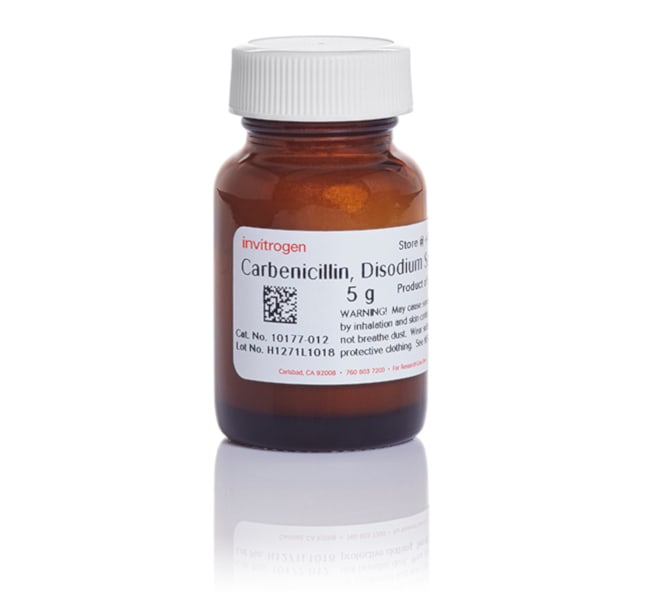Search Thermo Fisher Scientific

Certificates
SDS
Citations & References (6)
Gibco™
Carbenicillin Disodium Salt
Carbenicillin Disodium Salt is a semi-synthetic penicillin antibiotic with a carboxyl and benzyl group. Its mechanism of action is theRead more
 Promotion
PromotionPromotion:RELAX25
Reset, recharge, and fuel your next breakthrough
Until September 26, save up to $650 and get a science-inspired break boxLearn More
| Catalog Number | Quantity |
|---|---|
10177012 | 5 g |
Catalog number 10177012
Price (USD)
513.65
Online Exclusive
536.00Save 22.35 (4%)
Each
 Promotion available
Promotion availableIn stock
Quantity:
5 g
Price (USD)
513.65
Online Exclusive
536.00Save 22.35 (4%)
Each
Carbenicillin Disodium Salt is a semi-synthetic penicillin antibiotic with a carboxyl and benzyl group. Its mechanism of action is the same as ampicillin. It interferes with cell wall synthesis of gram-negative bacteria while displaying low toxicity to plant tissues. Gibco Carbenicillin is used as a selective antibiotic for resistant agrobacterium and E. coli, generally at a concentration of 50–100 μg/mL. The β-lactamase (bla) gene, which confers resistance to ampicillin, also confers resistance to carbenicillin. It is broken down more slowly by beta-lactamase compared to ampicillin, thus is more stable. It can reduce the growth of satellite colonies during long-term incubations. This product is provided as a powder and should be made into a stock solution of 50–100 mg/mL in water.
For Research Use Only. Not for use in diagnostic procedures.
Specifications
ColorWhite, off-white
Concentration50 to 100 μg/mL
Product LineGibco™
Quantity5 g
Shelf Life36 Months
Shipping ConditionWet Ice
FormPowder
Product TypeAntibiotic
SterilitySterile
Unit SizeEach
Contents & Storage
Storage conditions: 2 to 8°C
Shipping conditions: Ice
Shelf life: 36 months from date of manufacture
Shipping conditions: Ice
Shelf life: 36 months from date of manufacture
Have questions about this product? Ask our AI assisted search.
This is an AI-powered search and may not always get things right. You can help us make it better with a thumbs up or down on individual answers or by selecting the “Give feedback" button. Your search history and customer login information may be retained by Thermo Fisher and processed in accordance with our
Privacy Notice.
Frequently asked questions (FAQs)
Customers who viewed this item also viewed
Documents & Downloads
Certificates
Search by lot number or partial lot number
Lot #Certificate TypeDateCatalog Number(s)
57930325Certificate of AnalysisApr 02, 202510177012
57930125Certificate of AnalysisFeb 06, 202510177012
41620124Certificate of AnalysisJan 18, 202410177012
35180623Certificate of AnalysisJun 23, 202310177012
35180323Certificate of AnalysisApr 26, 202310177012
5 results displayed, search above for a specific certificate
Safety Data Sheets
SDS
Citations & References (6)
Search citations by name, author, journal title or abstract text
Citations & References
Abstract
The RNA Helicase DDX6 Controls Cellular Plasticity by Modulating P-Body Homeostasis.
Journal:Cell Stem Cell
PubMed ID:31588046
'Post-transcriptional mechanisms have the potential to influence complex changes in gene expression, yet their role in cell fate transitions remains largely unexplored. Here, we show that suppression of the RNA helicase DDX6 endows human and mouse primed embryonic stem cells (ESCs) with a differentiation-resistant, "hyper-pluripotent" state, which readily reprograms to
Nudt21 Controls Cell Fate by Connecting Alternative Polyadenylation to Chromatin Signaling.
Journal:Cell
PubMed ID:29249356
'Cell fate transitions involve rapid gene expression changes and global chromatin remodeling, yet the underlying regulatory pathways remain incompletely understood. Here, we identified the RNA-processing factor Nudt21 as a novel regulator of cell fate change using transcription-factor-induced reprogramming as a screening assay. Suppression of Nudt21 enhanced the generation of induced
High-throughput, image-based screening of pooled genetic-variant libraries.
Journal:Nat Methods
PubMed ID:29083401
We report a high-throughput screening method that allows diverse genotypes and corresponding phenotypes to be imaged in individual cells. We achieve genotyping by introducing barcoded genetic variants into cells as pooled libraries and reading the barcodes out using massively multiplexed fluorescence in situ hybridization. To demonstrate the power of image-based
Salmonella Persist in Activated Macrophages in T Cell-Sparse Granulomas but Are Contained by Surrounding CXCR3 Ligand-Positioned Th1 Cells.
Journal:Immunity
PubMed ID:30552021
Salmonella enterica (Se) bacteria cause persistent intracellular infections while stimulating a robust interferon-?-producing CD4
ATP-Dependent Dynamic Protein Aggregation Regulates Bacterial Dormancy Depth Critical for Antibiotic Tolerance.
Journal:Mol Cell
PubMed ID:30472191
Cell dormancy is a widespread mechanism used by bacteria to evade environmental threats, including antibiotics. Here we monitored bacterial antibiotic tolerance and regrowth at the single-cell level and found that each individual survival cell shows different "dormancy depth," which in return regulates the lag time for cell resuscitation after removal
6 total citations
